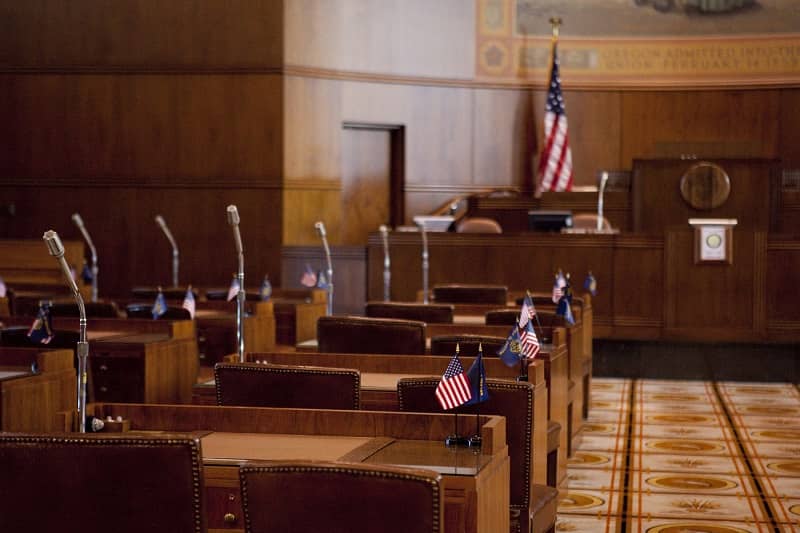By John A Charles, Jr. and Rachel Dawson
EXECUTIVE SUMMARY
The Oregon Public Purpose Charge (PPC) is a tax enacted by the Oregon Legislature in 1999, as part of SB 1149. The tax applies to ratepayers of Portland General Electric and PacifiCorp and is set at 3% of utility revenue.
The original reason for the tax was to create a revenue stream that could be used to subsidize energy conservation and renewable power projects within the service territories of the two electric utilities. Specifically, the PPC money was allocated as follows: 56% for energy conservation; 17% for funding the above-market costs of renewable energy; 12% for low-income weatherization; and 10% for energy conservation in schools. For political reasons, 5% of the PPC revenue was designated for construction of low-income housing, although this has nothing to do with energy conservation.
SB 1149 directed the two electric utilities to collect money from ratepayers and turn it over to various organizations to administer the required programs. The Public School Program is administered and overseen by the Oregon Department of Energy, with project implementation handled by school districts. The Oregon Housing and Community Services (OHCS) administers PPC funds for low-income weatherization and subsidized housing.
Almost 74% of PPC funds are designated for energy efficiency projects in homes and businesses, and the above-market costs of certain renewable energy projects. In 1999, no organization existed to administer such programs, so in November 2001 the Oregon Public Utility Commission (PUC) signed a grant agreement with a new nonprofit, the Energy Trust of Oregon (ETO). The Trust opened for business on March 1, 2002, and began receiving Public Purpose funds through the Oregon PUC.
Natural gas utilities were not affected by SB 1149. However, they were later brought into the fold by PUC stipulation.
During the 1999 legislative session, drafters of SB 1149 made it clear that this would be a temporary tax. The law stated that the PPC would go into effect in March 2002 and would end 10 years later in March 2012.
However, in 2007 a different group of legislators moved the sunset date for the PPC from 2012 to 2026, as part of SB 838. In addition, the new law authorized ETO to negotiate with the private utilities for an additional add-on tax that would pay for more energy efficiency work. The result was a combined energy tax (SB 1149/SB 838) that has grown to over 10% for many ratepayers who use both electricity and natural gas.
Total PPC Rates, 2016-2020*
| PGE | Pacific Power | NW Natural | Cascade Natural Gas | Avista Natural Gas | |
| 2016 | 5.7% | 5.5% | 2.5% | 4.4% | n/a |
| 2017 | 7.7% | 5.9% | 3.2% | 4.3% | 1.1% |
| 2018 | 7.1% | 5.5% | 4.0% | 4.3% | 1.1% |
| 2019 | 5.9% | 6.0% | 3.9% | 5.8% | 2.3% |
| 2020 | 5.6% | 5.6% | 3.7% | 4.9% | 2.7% |
*Includes assessments for schools, low-income and Energy Trust for electric utilities
From its inception in 2002 through July 2019, the original PPC collected roughly $1.33 billionfrom ratepayers for the “public purposes” laid out in the statute.However, the most cost-effective projects were done in the early years – exactly as the authors of SB 1149 envisioned. In the 2003-04 biennium, PPC administrators spent $91.4 million to acquire 1.7 million BTU of saved or generated energy. During the 2017-19 biennium, PPC costs had gone up to $159 million, but the energy savings were still 1.7 million BTU.
Trends in Cost-Effectiveness for PPC Expenditures by Energy Trust, OHCS and Public Schools
| Years | PPC Expenditures | Claimed savings or energy generated (MBTU) | Expenditure per MBTU |
| 2003-04 | $91,396,476 | 1,710,364 | 53.4 |
| 2005-06 | $121,070,476 | 2,021,518 | 60.3 |
| 2007-08 | $142,413,417 | 4,355,773 | 32.7 |
| 2009-10 | $176,725,248 | 1,751,822 | 100.8 |
| 2011-12 | $179,486,773 | 1,816,407 | 98.8 |
| 2013-14 | $157,980,241 | 1,914,424 | 82.5 |
| 2015-16 | $188,633,413 | 1,762,673 | 107.0 |
| 7/17-6/19 | $159,277,693 | 1,724,103 | 92.4 |
The costs per unit of energy saved or generated in the most recent biennium were 73.03% higher than in 2003-04.
Moreover, the numbers above are heavily skewed by the fact that the Energy Trust claims 100% of the credit for any renewable energy or conservation project it subsidizes, even if the PPC funding is just a tiny part of the overall cost. If ETO took credit in proportion to its investment of PPC funding, the reported savings (or generation of electricity from renewable energy projects) would be much smaller.
Warning lights about PPC expenditures have been flashing for some time. In 2012, Oregon Secretary of State Kate Brown released an audit of PPC spending in schools, showing that almost $40 million of savings had been missed and that 70% more energy could have been conserved if school districts had implemented the measures identified by energy audits as having the highest payback.
In some cases, PPC money had been used for projects that would never pay for themselves. For instance, Newberg School District installed insulated roofing panels at an elementary school in 2005 that had an estimated simple payback of 110.5 years and an expected life of 25 years. The measure was estimated to lose $65,150 over its lifetime.
The peak years for energy conservation in schools were 2007-2008, when 604 energy-saving measures were implemented. For the most recent biennium, there were only 123 measures implemented – the lowest number since the program began.
The Oregon Housing and Community Services (OHCS) department is required to ensure that they maintain a 1:1 ratio of PPC expenditures to energy saved for installed conservation measures. From 2002-12, the agency was able to do that six out of ten years. Since 2012, OHCS has never met the required standard.
The Energy Trust of Oregon receives 74% of PPC funds. In ETO’s flagship program – electricity savings – the Trust spent $14.7 million in 2003 and achieved savings at a cost of $0.11 per kWh. In 2017, ETO spent $157 million, but savings had a cost of $0.26 per kWh – an increase of 136%.
ETO’s renewable energy program was severely affected by the passage of SB 838 in 2007, which prohibited the organization from spending any more PPC money on utility-scale projects. Confined to small projects, ETO’s cost per megawatt of renewable energy has gone up by more than 1,400% since then.
By legislative design, the Energy Trust of Oregon was incorporated as a nonprofit charity under section 501(c)(3) of the IRS code. However, it is not actually a charitable organization. Roughly 99% of ETO’s annual revenue comes from the PPC, which is mandatory.
Nonetheless, over the five-year period of 2014-2018, ETO reported PPC revenue to the IRS totaling $847 million under the category of “gifts, grants, contributions, and membership fees.”
If PPC payments by utility customers are considered charitable gifts by the IRS, then ratepayers should be receiving receipts and deducting the cost of the PPC from their federal tax filings. In fact, this was anticipated by the founders of Energy Trust. Article IV of ETO’s Articles of Incorporation states, “It is intended that the Corporation qualify as an organization which is exempt from federal income taxation under Code section 501(c)(3), contributions to which are deductible for federal income, estate, and gift tax purposes….”
We are not aware of Energy Trust or any other administrator of the Public Purpose Charge ever issuing receipts to utility ratepayers for their $1.33 billion dollars of “donations.”
Most energy activists believe that the PPC should become permanent, and PPC administrators tend to agree. In fact, the 2020-2024 strategic plan for ETO explicitly assumes that the PPC will be extended past 2025. A legislative bill for that purpose was introduced in the state legislature during 2019, but did not pass out of committee. It will likely be introduced again in 2021.
The time has come for legislators to decide whether the original mission of the PPC has been accomplished, or if it should be expanded. Based on nearly a decade of research, this paper makes the following recommendations:
- The Public Purpose Charge has fulfilled its original, 10-year mission, and should be ended as soon as possible. The Oregon economy is reeling from COVID-19. PGE reports that customer accounts in arrears (31 days or more past due) are up 41% this year. There is no reason to maintain a costly energy tax of 6-10% for a program that has already served its purpose.
- If the PPC continues through 2025 or longer, the SB 1149 mandate related to small-scale renewable energy projects should be repealed. ETO’s renewables program has been made obsolete by multiple laws passed since 1999, including several “green power” mandates and a new solar subsidy program.
More than 99% of all ETO renewable projects have been solar electric. Since the installation costs of those projects have dropped by roughly 76% since the passage of SB 1149, the original intent of helping renewables transition to market-competitiveness has been met.
- The SB 1149 mandate for market transformation should also be repealed. There is no way to adequately define or measure the term “market transformation.” Moreover, the preeminent market transformation organization is the Northwest Energy Efficiency Alliance (NEEA), which already has its own funding from over 100 utilities.
- Between now and 2026, ETO should switch its more costly program offerings from cash grants to no-interest loans. The best way to ensure that a project is worth doing is to require significant “skin in the game” by recipients of public assistance.
A loan program would provide the up-front cash often needed to start a project, while imposing much-needed fiscal discipline. A loan program would also mean that any ongoing public purpose charge could drop over time to zero, because debt service payments would eventually make the fund self-supporting.
- ETO should utilize its tax status as a nonprofit institution regulated under Section 501(c)(3) of the IRS code to seek foundation grants and individual contributions. ETO claims that its various programs have saved ratepayers more than $7 billion dollars. If that is true, it should not be difficult to persuade many of them to donate to the Trust.
- The legislature should examine why Energy Trust of Oregon lists all revenue on its federal tax filings as “gifts, grants, contributions, and membership fees received,” yet ratepayers receive no gift receipts for PPC payments. The legislature has created a service delivery model that provides tax-exempt status to only one entity: the Energy Trust of Oregon. Ratepayers receive no such treatment. That contradiction should be addressed by the legislature in 2021.













Donna Hill
I have often discussed these issues with our Legislators over the years …ever since the Public Purpose Fund was enacted in 1999. The Legislators then said the fund was part of their Energy Bill and the Democrats would not accept it without the PP Fund being included. And it might have included the Low Income Assistance also. I also raised the question you bring up in this article about “gifts, etc”… and our being able to deduct from our taxes. I was “shot down” on that idea too.
Legislators in later years told me they couldn’t do anything as long as the Democrats were in majority. Well we all know where that goes since the Democrats have
had a majority for years and won’t let go of their grip.
Looking at my Pacific Power bill today made me even more aware as they added a new charge, A System Benefits Charge (291) and Low Income Assistance increased
from 69 cents to $1.04. Pacific power alone has 773,000 customers. My bill shows $12.14 for the “extra charges” having to do with conservation, etc. MILLIONS
are flowing into state coffers from all of the utility bills. I do not have anything against good programs but this certainly looks like overkill. The consumers are not
aware as they only see the small (so called) amounts on their bills and do not see “the BIG PICTURE”. Where does it end? (Klamath Falls 97603)